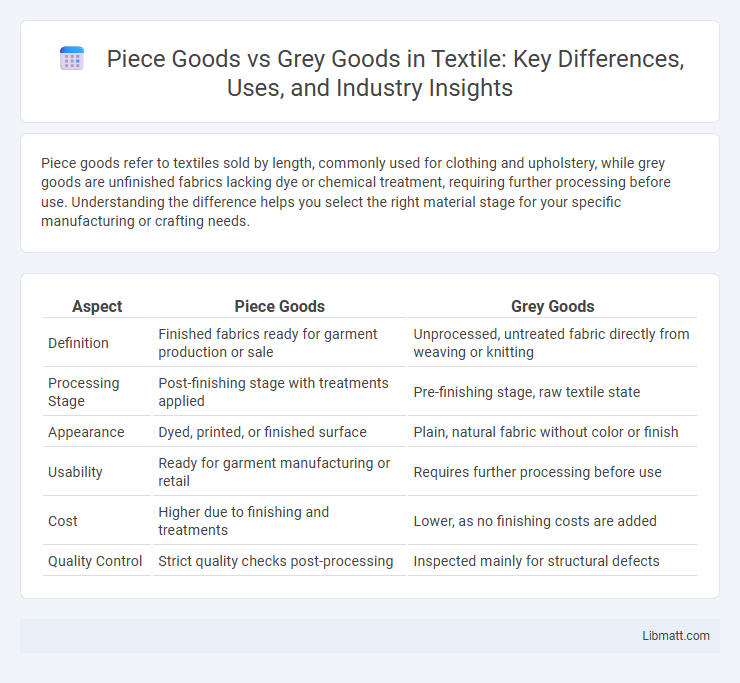Piece goods refer to textiles sold by length, commonly used for clothing and upholstery, while grey goods are unfinished fabrics lacking dye or chemical treatment, requiring further processing before use. Understanding the difference helps you select the right material stage for your specific manufacturing or crafting needs.
Table of Comparison
| Aspect | Piece Goods | Grey Goods |
|---|---|---|
| Definition | Finished fabrics ready for garment production or sale | Unprocessed, untreated fabric directly from weaving or knitting |
| Processing Stage | Post-finishing stage with treatments applied | Pre-finishing stage, raw textile state |
| Appearance | Dyed, printed, or finished surface | Plain, natural fabric without color or finish |
| Usability | Ready for garment manufacturing or retail | Requires further processing before use |
| Cost | Higher due to finishing and treatments | Lower, as no finishing costs are added |
| Quality Control | Strict quality checks post-processing | Inspected mainly for structural defects |
Introduction to Piece Goods and Grey Goods
Piece goods refer to fabrics sold in specific lengths, measured by the yard or meter, commonly used for custom tailoring and garment production. Grey goods are untreated, unbleached textiles in their natural state before any finishing processes, serving as the raw material for piece goods. Understanding the distinction helps you select the right fabric for your sewing or manufacturing needs.
Defining Piece Goods: Meaning and Examples
Piece goods refer to fabrics sold by length, often used in garment construction and home textiles, commonly measured in yards or meters. Examples include cotton plains, silks, linens, and printed fabrics, where each cut or piece is precisely measured before sale. Unlike grey goods, which are unprocessed fabrics, piece goods are finished materials ready for consumer use or tailoring.
What Are Grey Goods? Understanding the Concept
Grey goods refer to products that are imported and sold through unofficial channels, bypassing authorized dealers or distributors. These items are typically genuine but may lack official warranties or after-sales support in your region. Understanding grey goods is crucial for making informed purchasing decisions, as they can offer lower prices but come with potential risks related to quality assurance and customer service.
Key Differences Between Piece Goods and Grey Goods
Piece goods refer to textiles sold in specific lengths and widths, typically finished and ready for use, whereas grey goods are unfinished, unbleached, and undyed fabric rolls requiring further processing. Key differences include the stage of production--piece goods are processed and ready for immediate application, while grey goods are raw materials in the textile manufacturing cycle. Pricing and quality also vary, with piece goods generally commanding higher prices due to their finished state and grey goods costing less but needing additional treatment.
Advantages of Using Piece Goods
Using piece goods offers significant advantages such as greater customization and flexibility in fabric selection, allowing you to choose exact lengths suited for specific projects. This approach minimizes waste by purchasing only the necessary amount, making it cost-effective and environmentally friendly. Additionally, piece goods provide immediate access to various textures and patterns, enhancing creativity and tailored design options for your sewing or upholstery needs.
Benefits and Drawbacks of Grey Goods
Grey goods refer to products imported and sold through unofficial channels, often at lower prices than piece goods purchased from authorized retailers. You benefit from significant cost savings and wider availability, but face drawbacks including lack of manufacturer warranties, potential issues with product authenticity, and limited customer support. These risks make grey goods a cost-effective option if you prioritize price over guaranteed post-purchase service and official quality assurance.
Common Industries Using Piece and Grey Goods
Textiles and apparel manufacturing heavily rely on piece goods, which are uncut fabrics sold in measured lengths for garment production and upholstery. Grey goods, also known as greige or unfinished fabrics, serve industries such as home furnishings and industrial applications where further processing like dyeing or finishing is required. Your choice between piece goods and grey goods depends on the specific needs of sectors including fashion, upholstery, automotive textiles, and technical fabrics.
Impact on the Textile Supply Chain
Piece goods and grey goods significantly influence the textile supply chain by determining processing stages and quality control measures. Piece goods, being finished fabrics, require inspection and grading, which affects inventory management and distribution efficiency. Your sourcing strategies must adapt to the variability inherent in grey goods, which are unfinished textiles needing dyeing or finishing, introducing additional steps and potential delays in production timelines.
Buyer Considerations: Choosing Between Piece and Grey Goods
When deciding between piece goods and grey goods, you should evaluate factors such as customization needs, budget constraints, and production timelines. Piece goods offer flexibility for tailoring fabrics to specific designs, while grey goods provide cost-effective, unfinished textiles ready for finishing processes. Understanding your project requirements ensures the optimal choice that balances quality, lead time, and expense.
Future Trends in Piece and Grey Goods Markets
The future trends in piece goods and grey goods markets highlight increasing demand for sustainable and ethically sourced textiles, driven by consumer awareness and regulatory pressures. Digital innovation such as AI-powered inventory management and smart textile integration is reshaping production efficiency and product differentiation for both markets. You can expect heightened competition as manufacturers adopt eco-friendly practices and advanced technologies to meet evolving market expectations.
Piece goods vs Grey goods Infographic

 libmatt.com
libmatt.com